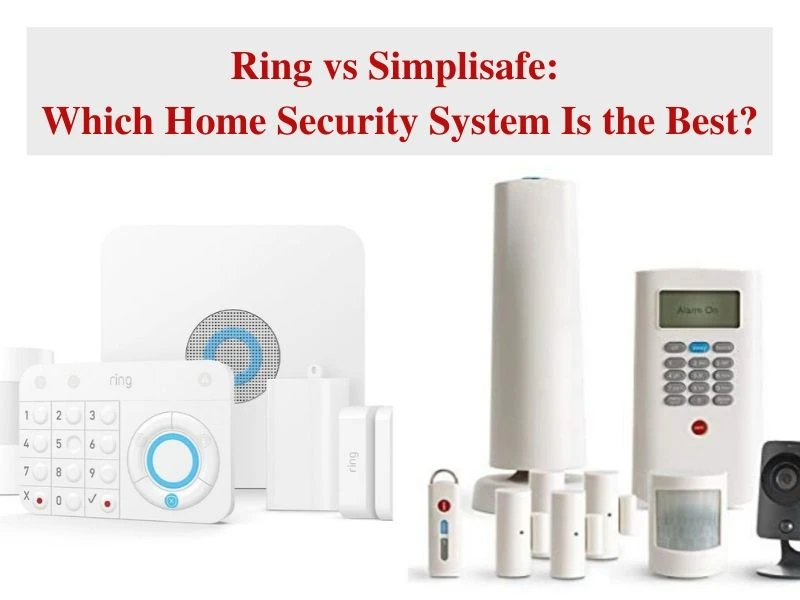Installing a home security system to protect your loved ones and valuables need not be expensive anymore! Today, you can purchase a modern, affordable, and do-it-yourself home security system with no long-term contract required.
Ring Alarm Home System and Simplisafe are the top contenders when it comes to affordable, DIY home security solutions. In this post, let’s take a look at these two big brands and compare their features to learn which one is the best for your needs.
Here’s a quick summary of Ring vs. Simplisafe:
| Features and Specs | Simplisafe | Ring |
|---|---|---|
| 24/7 monitoring | yes | yes |
| Camera options | Indoor | Indoor and outdoor |
| Home automation integration | yes | yes |
| Wireless | yes | yes |
| Battery type | lithium-ion | Lithium-ion or double A |
| Motion detection | yes | yes |
| Sensors | Doors and windows | Doors and windows |
| Mobile app | yes | yes (separate purchase) |
| Voice command | no | yes |
| Remote control | no | yes |
| Keypad | yes | yes |
| Range extender | yes | no |
| Add-on devices | 100+ | 20+ |
| Professional monitoring | Yes (pay separately) | Yes (pay separately) |
| Battery back-up | yes | yes |
| Warranty | 1 year | 1 year |
Here’s what we’ll cover:
Ring vs Simplisafe - the Similarities
Ring vs Simplisafe - the Differences
How to Find the Right Security System
FAQs About Ring and Simplisafe
Ring vs Simplisafe - Our Verdict
Wrapping It Up
Ring vs Simplisafe - the Similarities
Despite being competitors, both Ring and Simplisafe offer a handful of similarities:
DIY Installation
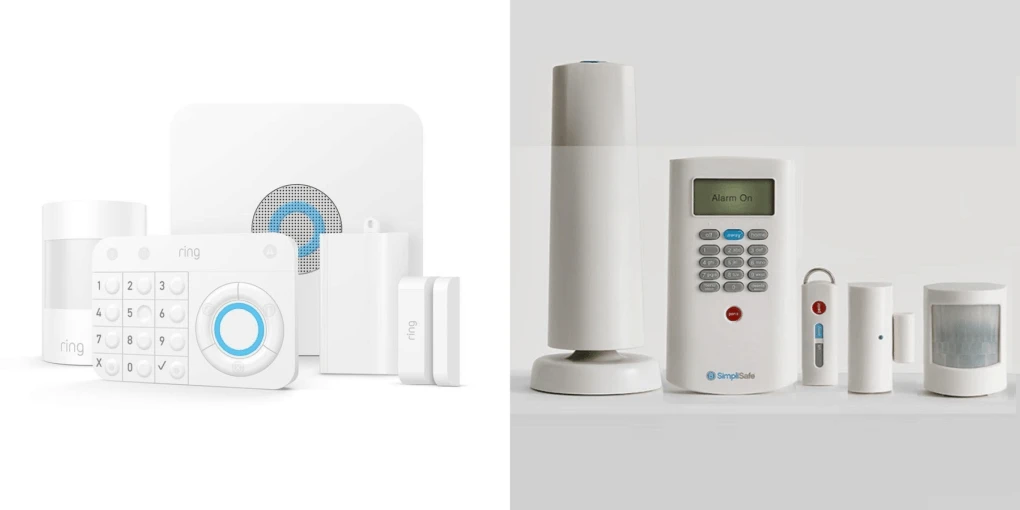
Unlike traditional systems, modern security systems like Ring and Simplisafe can be easily installed without the need for a professional. The devices are simply plug-and-play - just take the base station and plug it, take the wireless devices and place them anywhere that you think needs monitoring. Most of them attach to the wall with double-sided adhesive.
24/7 Professional Monitoring
Having peace of mind is one of the many reasons why you would want a 24/7 professional monitoring service. Whether you’re working away from home on traveling for a vacation, you want to keep an eye on your home and be notified immediately in case of emergencies. If you or your contacts can’t be reached, the system can automatically call the authorities to the rescue.
Both Ring and Simplisafe offer this feature but is not included for free on the basic package. You will need to add a monthly fee to get the service.
Ring charges $3 per month for their monitoring programs, and Simplisafe charges $14.99 for theirs.
| Pricing | Simplisafe | Ring |
|---|---|---|
| Price starts at | $14.99 per month | $3.00 per month |
| Upfront cost starts at | $299.96 | $99.99 |
| Contract | Month-to-month | Month-to-month |
| Money-back guarantee | 60 days | 30 days |
Siren
Ring and Simplisafe designed their hubs with a siren so that you can hear an alarm during emergency situations. But what if break-ins happen and the burglar is smart enough to smash your system? Fortunately, both big brands offer extra sirens as a redundancy so that you or your neighbors would still be alerted in case your built-in siren is disabled.
Video Monitoring
Ring and Simplisafe both offer smart cameras to add video monitoring for your security system. On top of the sensors, you can now see the actual event in case there’s danger or emergency through live streaming.
We find that a camera is good for two reasons:
- It let’s you rule out false alarms before calling the cops
- Telling the emergency dispatcher that you can see people that have broken into your home is guaranteed to get a quick response from law enforcement
Multiple Wireless Keypads
Keypads offer a convenient way to access your alarm system, especially if you expect children or guests to be using your system (so they wouldn’t have the app on their phone). You can install it in a convenient place in your house, like a main door or on multiple floors in your home. Installing multiple keypads in your house allows you to easily arm or disarm your system and avoid false alarms.
Cellular & Battery Backup
You don’t want your whole system down when there is a power interruption - emergencies could happen anytime! Fortunately, both Ring and Simplisafe includes a free battery back-up so that all of your devices will still run smoothly.
What about a flaky internet connection? In the event of an outage, both products offer 4G cellular backup so that you can still control your system and keep an eye on your home. However, the cellular backup is not free - you will need to invest an additional monthly fee to get the service.
For Ring, it’s $10/month which already includes professional monitoring. For Simplisafe, it’s $14.99/month.
Flexible Contract
Committing to a long-term security monitoring contract sucks. Fortunately, both Ring and Simplisafe offer monthly contracts that you can cancel anytime. This means you can have more flexibility without the hassle of being stuck in a long-term commitment.
Ring vs Simplisafe - the Differences
Now, let’s take a look at the differences between Ring and Simplisafe. Depending on your preferences, how the systems differ will definitely help you make your decision.
Wireless Communication
One of the differences between the two big brands is the technology used for communication between devices. Simplisafe’s communication is limited only to WiFi, a disadvantage for smart home integration. On the other hand, Ring uses not just WiFi to communicate but also Zigbee and Z-Wave, making it more flexible than just a simple WiFi setup.
Internet Connection
While both Ring and Simplisafe allow your devices to communicate via WiFi, sometimes you might need to connect your device directly to a router for speed and reliability. Simplisafe can only connect through WiFi and doesn’t have an option to connect to a router through the ethernet cable. On the other hand, Ring offers not just WiFi connectivity but also an ethernet connection, making it more flexible and potentially more reliable.
Disarm Options
When it comes to disarming the system, both Ring and Simplisafe have the option to do it through an app or keypad. However, Simplisafe offers an additional option to arm or disable your security system through a keychain remote. And what makes it more attractive is the convenience.
With a keychain remote, you can easily hand it over to your family members or housekeepers to arm or disable the system. Guests won't have to enter a code to the keypad or install an app since you can just hand them over a fob.
Voice Command
One of the disadvantages of owning a Ring Alarm System is the lack of support for voice command. Simplisafe, on the other hand, can be easily armed or disarmed through Google Assistant or Alexa. Ring can only be controlled through a keypad or an app.
This could definitely change pretty quickly with a software update, but for now, it’s a deficiency of the Ring system.
Color
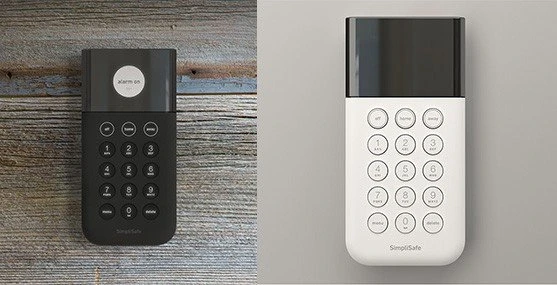
Simplisafe offers a modern and sleek design of their devices that is available in white or black. Ring, on the other hand, is only available in white.
It may seem trivial, but there’s definitely value in having a system blend in and fit well in your home.
Sensors
Motion and entry sensors are the most essential parts of a security system. These sensors are used to detect activities nearby and send an alarm signal to the base station when unexpected activities or movements are detected. Some carbon monoxide sensors are also important since they help alert you when there is a fire or gas leak. Both Ring and Simplisafe offer these essential sensors.
However, Simplisafe does offer additional sensors for temperature and glass break detection that you won’t find in a Ring Alarm System.
Temperature sensors allow you to monitor room temperatures and prevent burst pipes during cold seasons. Glass break sensors helps by adding an extra line of protection in case an intruder breaks your glass window to get inside your home. But, some have problems with false alarms during storms with nearby lightning.
Although Ring doesn’t have its own temperature and glass break sensors, the system does offer compatibility with third-party devices that use Zigbee and Z-Wave. This makes it easier for you to add third-party devices such as temperature and glass break sensors with your Ring Alarm System.
Panic Button
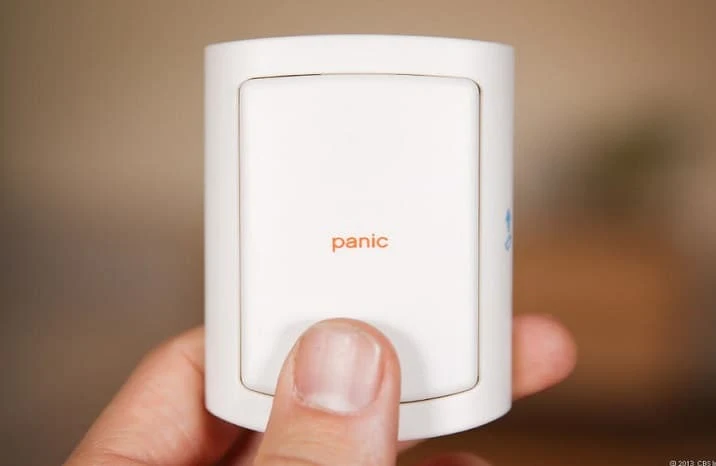
A panic button is also one of the important features of a security system during emergencies. When you activate it, the system will contact a monitoring center which will then call you back to check on you. If they don’t receive your response or safe word, they will immediately contact the authorities to go to your house. Both Simplisafe and Ring offer this feature, but Simplisafe offers more versatility and convenience.
Simplisafe has a remote button which you can press during emergencies. It also features a silent panic button that will contact the authorities without setting off an obvious alarm. In the event of a burglary (especially in a business or retail store), you don’t want the intruders know that you’re calling the police.
Unlike Simplisafe, Ring’s panic button is needs access to the keypad and doesn’t have a silent alarm option, making it more obvious, which may not be ideal in a dangerous situation.
Smart Home Integration
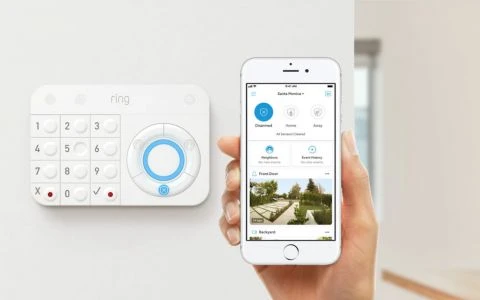
While Ring Alarm offers easy integration with other Ring products like security cameras and doorbells, it’s still limited for third-party devices. Hopefully, more integrations can be added over the years.
Subscription Price
When it comes to subscription packages, Simplisafe is more expensive than Ring.
Simplisafe offers the Standard plan at $15 per month and Interactive at $24.90 per month. The Standard plan offers the basic features for your home security such as cellular backups, environment monitoring and 24/7 live alarm monitoring. However, you have to subscribe to Interactive to unlock some of the features like secret alerts, video alarm verification, mobile alerts, and controlling the system through your smartphone.
Ring, on the other hand, offers all the essentials at only $10 per month. The plan already includes video storage, cellular backup, and can be shared across your Ring products. So overall, Ring is far cheaper than Simplisafe.
Tips for Choosing A Security System
Although Ring and Simplisafe have their own pros and cons, you need to consider the following features when choosing a home security system:
Installation
Most modern security systems are DIY and easy to set up. However, if you want someone else to do the work, consider that Ring is completely DIY, and they don’t offer professional installation services. On the other hand, Simplisafe gives you an option to have your devices installed by a professional.
Compatibility
When installing a smart home system, you may want to add devices over time to grow your system. So it is critical to find a security system that doesn’t have compatibility issues. Your first system will serve as the foundation of your home security. Do your research and search for a system that can be easily integrated with multiple devices. This will help you save time and money in the long run.
Price
When choosing a home security system, it is important to consider the upfront cost as well the amount you will have to spend in the long run. Ring and Simplisafe doesn’t require you to commit to a long term contract, which means greater savings compared to other traditional companies. However, this also means you will have to purchase all the equipment upfront. Companies that lock you in a long term contract spread the payment of the devices over months or years, which means lower upfront cost and reduced flexibility.
FAQs About Ring and Simplisafe
1. Which brand is more expensive?
Overall, Ring is more affordable than Simplisafe. Ring's upfront cost is $99 and professional monitoring starts at $3 per month. On the other hand, Simplisafe has an upfront cost of $299.94 and subscription plan starting at $14.99.
2. Do Ring and Simplisafe offer DIY installation and monitoring?
Both Ring and Simplisafe are DIY systems. This means you can install the devices all by yourself without the need of a professional. You can also monitor both systems using your smartphone without a contracted service.
3. Do you need to pay a monthly fee?
If you subscribe to a plan, you will need to pay $3 for Ring and $14.99 for Simplisafe.
4. Do you need to commit to a contract?
Both Ring and Simplisafe don’t require you to commit to a long-term contract.
5. Do they offer doorbell video options?
Both Ring and Simplisafe have doorbell video options.
6. Do Ring and Simplisafe include an app for remote access and monitoring?
Yes
7. What sensors are included in the package?
The following packages are available from Ring:
RING SECURITY SYSTEM |
5-PIECE ALARM SECURITY KIT |
8-PIECE ALARM SECURITY KIT |
14-PIECE ALARM SECURITY KIT |
|
Price |
$199 |
$259 |
$329 |
|
Base station |
1 included |
1 included |
1 included |
|
Keypad |
1 included |
1 included |
2 included |
|
Contact Sensor |
1 included |
3 included |
8 included |
|
Motion Detector |
1 included |
2 included |
2 included |
|
Range extender |
1 included |
1 included |
1 included |
The following are the packages available for Simplisafe:
|
The Essentials $259.95 |
The Hearth $374.91 |
The Barrington $388.93 |
|
1 SimpliSafe base station 1 SimpliSafe keypad 3 entry sensors 1 motion sensor |
1 SimpliSafe base station 1 SimpliSafe keypad 3 entry sensors 1 motion sensor 1 smoke detector 1 keyfob |
1 SimpliSafe base station 1 SimpliSafe keypad 2 entry sensors 1 motion sensor 1 key fob 1 panic button SimpliCam indoor camera |
8. Are the devices connected automatically to law enforcement and fire agencies in case of emergencies?
Ring and Simplisafe both automatically call the authorities during emergencies when you subscribe to their plans.
9. What technology is used for communication?
Simplisafe devices can only communicate through WiFi while Ring devices communicate via WiFi, ZigBee and Z-Wave protocols.
10. Does it need an internet connection? Can you wire it directly to the router?
Both Ring and Simplisafe can communicate through WiFi. However, only Ring has the feature that allows you to connect directly to a router via the ethernet cable.
11. Can I disarm the system remotely?
Both Ring and Simplisafe can be disarmed remotely through an app.
12. Do they have panic buttons?
Both Ring and Simplisafe have panic buttons.
13. What subscription options are available?
Simplisafe offers the Standard plan at $15 per month and Interactive at $24.90 per month. Ring, on the other hand, offers all the essentials at only $10 per month.
14. Is there a voice control option available?
Only Simplisafe is voice controlled through Google Assistant or Alexa. Ring doesn’t have this feature.
15. Are they compatible with an existing home security system?
Simplisafe offers compatibility with a large number of devices while Ring is mostly limited to Ring products only.
16. Is there an option for professional monitoring?
Both Simplisafe and Ring offer professional monitoring services through a subscription plan.
17. Does it have a battery and cellular back-up?
Both Ring and Simplisafe include a free battery back-up as well as 4G cellular backup.
18. Does it have a built-in siren?
Both Ring and Simplisafe offer a hub with a built-in siren as well as an optional external siren for redundancy.
Ring vs Simplisafe - Our Verdict
When it comes to cost, it’s obvious that Ring has the edge over Simplisafe. Ring offers lower upfront cost and subscription plan at $3 per month which already includes all the essentials you need for a home security system. Simplisafe’s upfront cost is higher and the subscription plan starts at $14.99. However, you would need to upgrade to a premium plan to unlock all the features, making it much more costly than Ring.
The only downside of Ring is its limited smart home integration and lack of voice control feature.
Wrapping It Up
Ring and Simplisafe are designed be to DIY systems which you can easily set up at home without a professional. They offer many of the same features but differ a lot when it comes to subscription and upfront costs. Overall, these top two contenders are still cheaper compared to traditional brands and definitely worth your money.
In the end, you’ll have to decide how important smart home integration and costs are to you to make the final call. For us, Ring is a clear winner with the current feature set.
Hi, I’m Christy, and I’m an electronics engineer by profession. I have taught in a university for 2 years while pursuing my master’s degree in cognitive radio and worked for a company to develop wireless medical devices. Currently, I’m doing research for a doctorate degree in engineering using a wireless sensor network for smart agriculture. I’ve been active in our local IoT community, IoT Cebu, where I participate in conducting talks about Arduino, Raspberry Pi, and DIY home automation using Wi-Fi and ZigBee devices.
